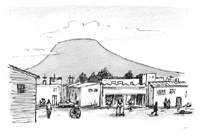
|
|
Volcano Under the City
|

|
|
Program Overview
|

|
 NOVA investigates the dangers of Nyiragongo volcano, located in a
densely populated valley in the heart of Africa.
NOVA investigates the dangers of Nyiragongo volcano, located in a
densely populated valley in the heart of Africa.
The program:
-
recounts Nyiragongo's 2002 eruption, which left more than 100
people dead and another 100,000 homeless.
-
describes two main types of volcanic eruptions: explosive, as
seen at Mt. Saint Helens where lava shot up 25 kilometers, and
effusive, as seen in Hawaii, where lava is very fluid and erupts
wherever it can.
-
notes that Nyiragongo is an effusive volcano characterized by an
extensive network of fissures—which now extend beneath the
city of Goma—that can fill with magma and erupt.
-
points out that the volcano contains lava that has been clocked
at speeds of almost 100 kilometers per hour, making it the
fastest-moving lava on Earth.
-
outlines how scientists forecast volcanic eruptions through the
use of seismology, land deformation, and geochemistry, which
they measure with seismology readings, satellite imagery, and
gas fume sampling.
-
relates another threat facing Goma—concentrations of
deadly carbon dioxide gas at the bottom of Lake Kivu that could
be released through earthquake or lava eruption from Nyiragongo.
-
shows people building homes in the path of a potential lava flow
because they are unafraid of the volcano's dangers or unable to
go elsewhere.
-
follows volcanologists as they descend into the volcano's crater
to collect gas and lava samples.
-
describes the dangers scientists face as volcano walls begin to
collapse, forcing the team to abandon its efforts.
-
follows the team as it returns to the crater to attempt a new
lava collection method.
-
details how scientists examine gas and lava samples to gain
information about the volcano's current state.
-
summarizes evidence showing a very active volcanic system that
could quickly erupt stored magma, flood the city with lava in
minutes, and release toxic gases from the nearby lake—all
of which could lead to a catastrophic natural disaster.
Taping Rights: Can be used up to one year after the program
is taped off the air.
|

|
